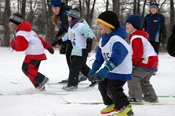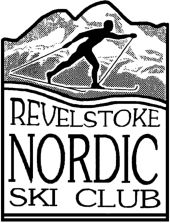 The first level of our youth programs is the Bunnies Program, which is directed at children in the “Active Start” stage of development (children five years of age and younger). Program materials include an enrollment kit, a child-friendly age-appropriate booklet and skill award stickers. The Bunnies program has been developed in parallel with the first level of the new competency-based National Coaching Certification Program, which now provides coaching materials specific to the needs of this age group. The objective of the program is to introduce cross-country skiing and the healthy lifestyle associated with it, through organized activity and active play. In addition, the program is designed to:
The first level of our youth programs is the Bunnies Program, which is directed at children in the “Active Start” stage of development (children five years of age and younger). Program materials include an enrollment kit, a child-friendly age-appropriate booklet and skill award stickers. The Bunnies program has been developed in parallel with the first level of the new competency-based National Coaching Certification Program, which now provides coaching materials specific to the needs of this age group. The objective of the program is to introduce cross-country skiing and the healthy lifestyle associated with it, through organized activity and active play. In addition, the program is designed to:
- Help children develop a positive self-image.
- Provide children an opportunity to make ski friends.
- Develop fundamental movement skills.
- Help children develop an awareness and appreciation of our natural environment.
Clothing:
Layers are the key to dressing for cross-country skiing. Layers provide the flexibility to adapt clothing according to the needs of the day. An enthusiastic skier can generate a great deal of body heat and perspiration even on the coldest days, so it is important to be dressed in such a way that allows excess heat and moisture to dissipate away from the body. These layers can be removed or replaced at will, even while on an outing. The layer next to the skin should be made from a material (polypropylene or wool) that keeps moisture and perspiration away from the skin and retains its insulating qualities when wet.
Cotton should be avoided in all materials as it retains moisture and keeps a person colder.
- Tops: A polypropylene shirt covered by a polar fleece sweater and a windbreaker or light insulated jacket is quite warm, allows excess heat and moisture to escape, and repels the snow.
- Bottoms: Instead of insulated snow pants, have light wind pants or rain pants over one or two thin layers of polypropylene or polar fleece. This will provide sufficient warmth, freedom of movement, and repel the snow.
- Head: There is potential for great heat loss through the head. A warm polar fleece, light synthetic, or wool toque that protects all of the ears is essential. Headbands or buffs can be worn on warmer days.
- Hands & Feet: Hands are the first body part to become uncomfortable in the cold, so a good pair of gloves or mitts is critical. Many use shelled Thinsulate or polar fleece liners with a water repellent/waterproof shell. Bringing a spare pair along on an outing is good insurance in case the first pair gets wet from making too many snowballs! Proper socks are important for warm feet (avoid cotton). A wool blend with polypropylene or some other synthetic is ideal.
- Eyes: A comfortable pair of UV-protective eye wear is an important element of the cross-country skier’s gear. Interchangeable lensed sunglasses or economical protective eye wear are important to protect from UV and sharp pole tips! (UVEX and MEC carry good options).
Boots & Bindings:
SNS and NNN are the two most commonly used boot/binding systems. Both are good and equally functional. Boots must be comfortable. If they are too large they will be awkward to ski in and if they are too small, the child’s feet will not stay warm. To check for a proper fit, loosen the boot and push the foot to the front of the boot. You should be able to fit a finger behind the child’s heel.
Skis & Poles:
Our Bunnies should have waxless skis with a contemporary binding (i.e. NNN or SNS). To find the appropriate length for skis take a measurement between the top of the child’s head and the wrist of an up-stretched arm; skis should be shorter rather than longer. Typically the skis should be no longer than 100 to 130 cm for Bunnies. Poles are not needed for Bunnies and in fact we discourage their use as they interfere with learning proper balance.
Ski equipment and ski preparation tips
Winter Safety
My Trail Etiquette Promise
